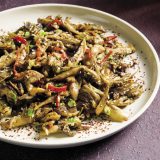In South Korea’s Buddhist monasteries, monks adhere to a diet known as temple cuisine, a strict vegan regimen that also eschews any variety of allium—its digestion is considered a distraction during meditation. Which doesn’t mean the food lacks flavor.
Quite the opposite, in fact. Funky fermented sauces, fiery chilies, tart pickled vegetables and a broad array of ingredients foraged across the mountains bring bold flavor.
“A lot of monks would forage, and my grandmother, too,” says Sohui Kim, chef of New York City’s Insa. Her grandmother frequently took her on these foraging adventures. “Everything from edible weeds to tree bark to mushrooms, anything the mountain had to offer.”
Kim grew up in Seoul, but moved to the United States at age 10. “I have specific memories of being so bored on these hikes, but they’d end up finding the most amazing delicacies, although to my young palate it was hard to appreciate.”
Kim has since learned to appreciate those walks. Maybe not the bark, but definitely the mushrooms. She notes that in many East Asian cuisines, mushrooms take the place of meat in stews or stir-fries thanks to their substantial texture and beefy flavor. In Korea, they often end up stir-fried with simple seasonings for a neutral banchan, or small plate, to be served among other spicy or salty ones.
High heat, a pinch of salt and a little oil often are all they need. But in the recipe in her book, “Korean Home Cooking,” Kim punches up the flavor with several ingredients, given that American meals typically only include a few components, rather than a spread of up to two dozen.
She browns a mix of cremini and shiitake mushrooms in a searing hot skillet before adding green chilies, soy sauce, sesame oil, anchovy stock, rice vinegar and silgochu, or Korean chili threads, for garnish. Even garlic and scallion whites make it in for an allium bite.
The savory combination is hardly neutral, more like an umami bomb that we loved. Each ingredient acted to season the mushrooms, but also enhanced their natural earthiness, making them taste more meaty. “The simplicity of this sautéed mushroom dish is beyond borders and could accompany myriad dishes,” she says.
A high-heat skillet was key to achieving the deep brown color we were after, though we lowered the heat when adding the liquid ingredients to keep them from burning. We added sesame seeds for textural contrast and used the scallion greens and whites for an extra herbal quality; additional rice vinegar balanced the umami depth.
The stir-fry came together in just a few minutes for a savory side—a little salty, a little spicy, fully satisfying.
Korean Stir-Fried Mushrooms Are Seared and Savory
A high-heat sear helps render a blend of mushrooms meaty and savory.
Photo: Connie Miller of CB Creatives; Styling: Monica Mariano








